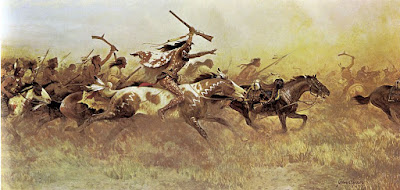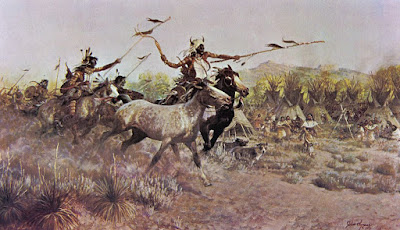John Ford Clymer (January 29, 1907 - November 2, 1989) was an American painter and illustrator known for his work that captured nature and the American West.
Born in Ellensburg, Washington, Clymer first studied art through the Federal School correspondence course. He continued his study in Canada, where he spent eight years illustrating for Canadian magazines.
In 1932, he married his childhood sweetheart, and five years later, in the fall of 1937, John and Doris Clymer moved to Westport, Connecticut, where he established his career as an illustrator for American magazines, including Argosy, The Saturday Evening Post, Woman's Day and Field and Stream.
While in the Marine Corps, he illustrated for Leatherneck Magazine and the Marine Corps Gazette. His work in advertising included paintings for White Horse Scotch Whisky, the Pennsylvania Railroad and the Chrysler Corporation. (Wikipedia)
Born in Ellensburg, Washington, Clymer first studied art through the Federal School correspondence course. He continued his study in Canada, where he spent eight years illustrating for Canadian magazines.
In 1932, he married his childhood sweetheart, and five years later, in the fall of 1937, John and Doris Clymer moved to Westport, Connecticut, where he established his career as an illustrator for American magazines, including Argosy, The Saturday Evening Post, Woman's Day and Field and Stream.
The Gold Train
Out of the Silence
Winner of the Prix de West Award, 1976 National Academy of Western art Exhibition.
Permanent Collection of the National Cowboy Hall of Fame, Oklahoma City
Land of Plenty
Northern Plains Indians are depicted cutting off a small segment of a buffalo herd (1970)
NEZ PERCE 1877 - ESCAPE FROM THE BIG HOLE
Chief Joseph, in the foreground, leads his Nez Perce band through Big Hole Valley after the Big Hole Battle in 1877.
THE WHITE BUFFALO
A white buffalo was considered by most Indian tribes as great medicine. (1972)
CRAZY HORSE
Crazy Horse during the Rosebud fight which took place on June 17, 1876. Holding his Winchester aloft like a lance, he leads his followers into the battle.
NIGHT VISITORS
A fire could attract unwelcome visitors so the trappers had to be continually vigilant.
THE TRADER
A trader with his helpers comes into an Oglala Sioux winter camp with trade goods, presents for the chiefs - and often with kegs of whisky hidden under packs to exchange for robes and furs.
SURVIVAL
Men of the Stuart party are falling upon an old buffalo carcass and in their starving con dition are cutting off and eating raw strips of meat.
BEAVER MEN
Trappers and mountain men, who had to be daring and resourceful to survive, are shown approaching a beaver pond with a beaver house in the foreground.
VICTORY RIDE
A victorious war party of Plains Indians is returning to camp with both scalps and horses.
MOVING CAMP
The late fall hunt is over and this band of Crow Indians is moving out to a sheltered valley to spend the cold winter months.
ALOUETTE
Surrounded by dangers the trappers still had their moments of gaiety.
THE BOOSHWAY
Trading companies hired groups of trappers to trap a particular territory. Each group had a leader or Bourgeois, pronounced "Booshway".
TIME OF HUNGER
This solitary cougar discovers the fresh scent of a snowshoe rabbit and becomes alert and ready to follownthe trail.
THE WHITE BUFFALO
A white buffalo was considered by most Indian tribes as great medicine. (1972)
CRAZY HORSE
Crazy Horse during the Rosebud fight which took place on June 17, 1876. Holding his Winchester aloft like a lance, he leads his followers into the battle.
NIGHT VISITORS
A fire could attract unwelcome visitors so the trappers had to be continually vigilant.
THE TRADER
A trader with his helpers comes into an Oglala Sioux winter camp with trade goods, presents for the chiefs - and often with kegs of whisky hidden under packs to exchange for robes and furs.
SURVIVAL
Men of the Stuart party are falling upon an old buffalo carcass and in their starving con dition are cutting off and eating raw strips of meat.
BEAVER MEN
Trappers and mountain men, who had to be daring and resourceful to survive, are shown approaching a beaver pond with a beaver house in the foreground.
VICTORY RIDE
A victorious war party of Plains Indians is returning to camp with both scalps and horses.
MOVING CAMP
The late fall hunt is over and this band of Crow Indians is moving out to a sheltered valley to spend the cold winter months.
ALOUETTE
Surrounded by dangers the trappers still had their moments of gaiety.
THE BOOSHWAY
Trading companies hired groups of trappers to trap a particular territory. Each group had a leader or Bourgeois, pronounced "Booshway".
TIME OF HUNGER
This solitary cougar discovers the fresh scent of a snowshoe rabbit and becomes alert and ready to follownthe trail.
The Western Paintings of John Clymer, Introduction by Paul Weaver; a Peacock Press/Bantam Book, Toronto, New York, London

















Keine Kommentare:
Kommentar veröffentlichen